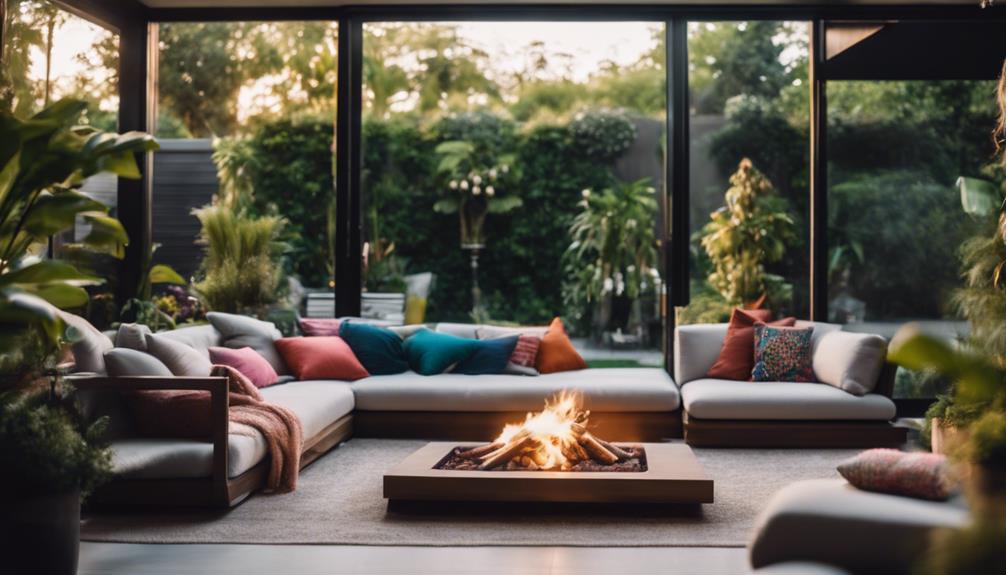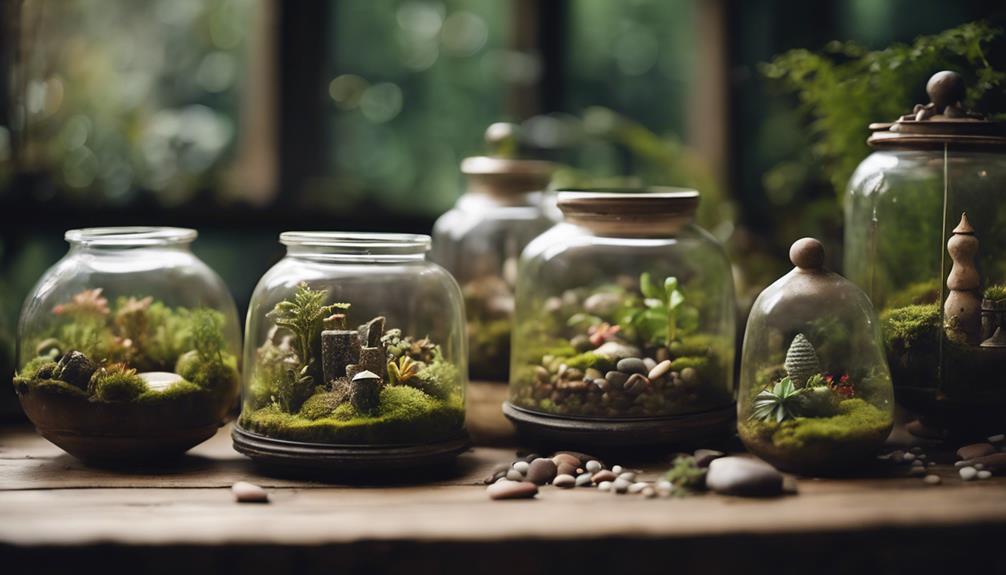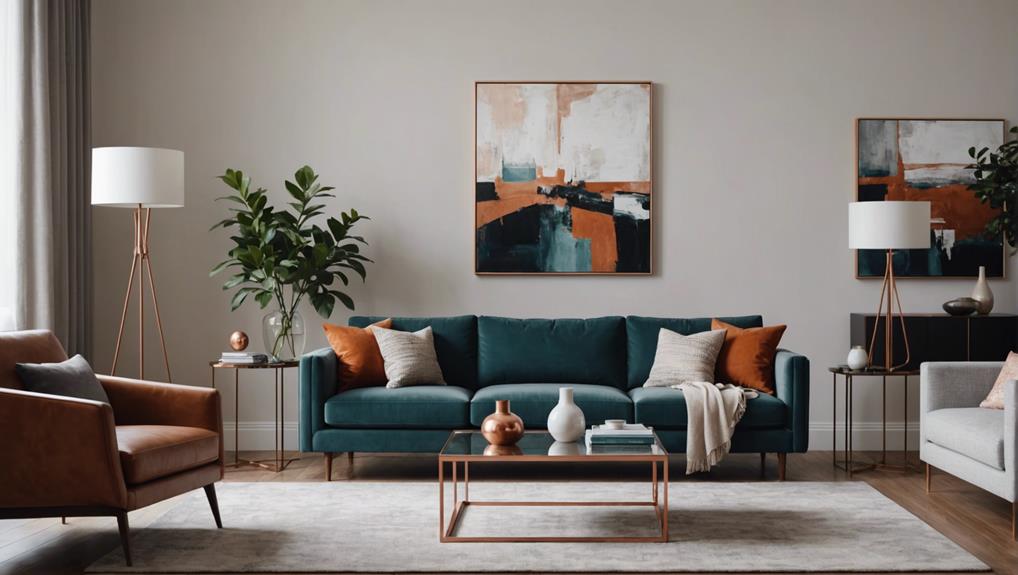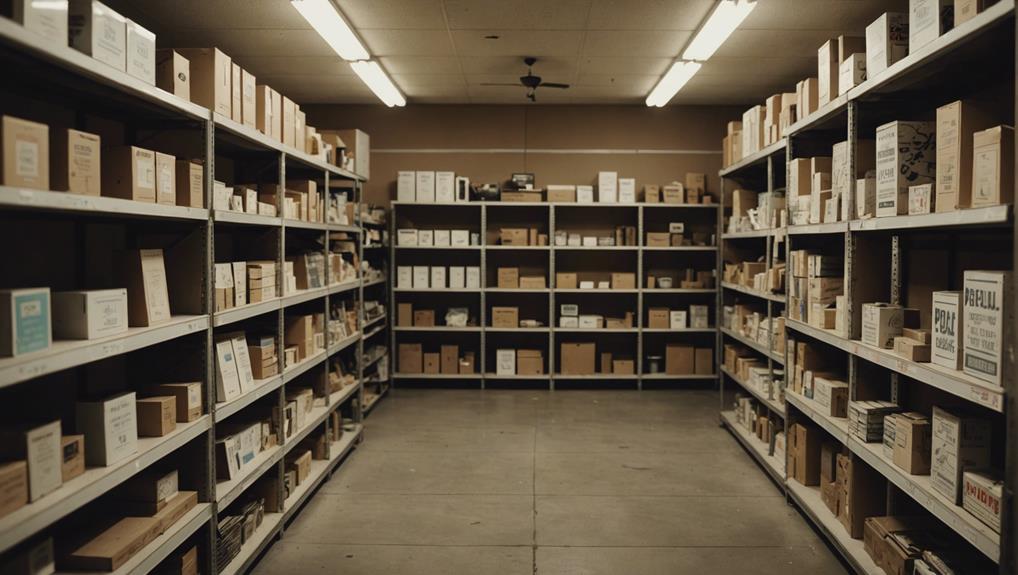You can easily create a charming cottagecore-inspired garden nook, even without a green thumb. Start by selecting low-maintenance plants like succulents and lavender, and use decorative pots for a cozy feel. Incorporate vintage furniture, like wicker chairs with floral cushions, to enhance comfort. String fairy lights or hang lanterns for a warm glow as the sun sets. Add unique decorative elements, like macramé hangers and hand-painted pots, for a personal touch. Don't forget to create a cozy flooring area with synthetic grass or reclaimed wood. There's more to discover to make your nook truly enchanting!
Key Elements
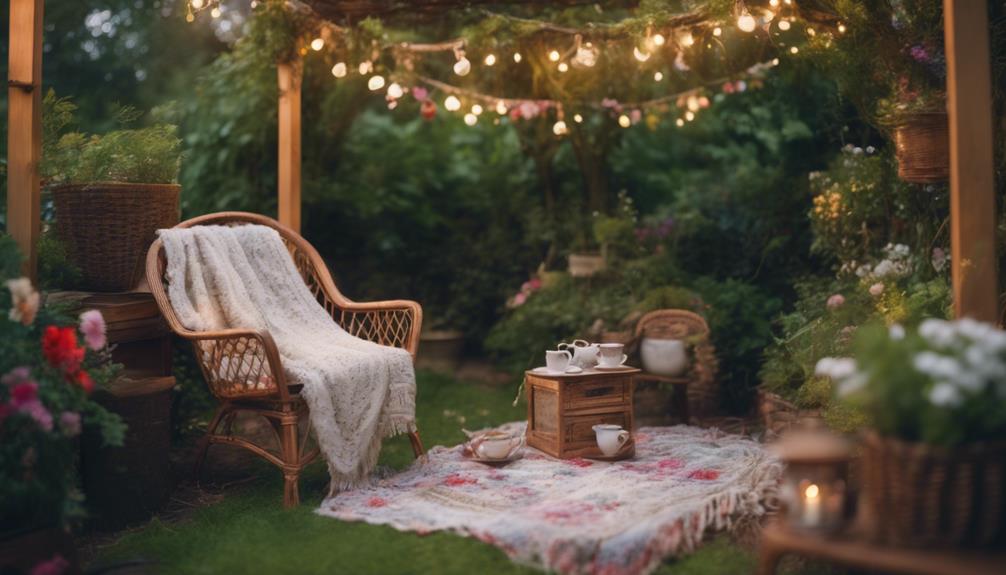
When creating your cottagecore-inspired garden nook, you'll want to focus on a harmonious color scheme that evokes warmth and tranquility.
Choose materials that reflect a rustic charm, like wood and stone, and layer different textures to add depth and comfort to your space.
Color Scheme
A soft, earthy color palette featuring pastel shades of lavender, blush pink, and sage green creates the serene atmosphere vital for your cottagecore-inspired garden nook. This color scheme sets a calming foundation, allowing you to enjoy your outdoor space without overwhelming your senses.
To add a whimsical touch, incorporate vibrant floral patterns through cushions and throws that echo the natural beauty of your garden. You can introduce pops of color with seasonal blooms like daisies, sunflowers, and hollyhocks, which not only enhance visual interest but also attract delightful pollinators.
Balance this lively color scheme with shades of cream and beige in your planters and accessories, creating a light and airy feel while allowing your plants to stand out. Using natural materials like wood and stone in your furniture and decor will further enhance the rustic charm of your nook and guarantee a cohesive look with muted tones.
Materials
Choose materials that resonate with the rustic charm of cottagecore, emphasizing natural textures and finishes to create a cozy garden nook.
Start with low-maintenance plants and flowers like succulents, ferns, and lavender. These thrive in various conditions and require minimal care, ensuring your garden nook remains lush and inviting without extensive gardening skills.
For planters, opt for decorative pots made from terracotta or woven baskets. These materials enhance the rustic aesthetic while providing a cozy feel that fits perfectly with your theme.
Consider incorporating cozy seating options, such as a vintage chair or a repurposed bench, adorned with soft cushions and throws for comfort.
To add whimsy, introduce elements like fairy lights or lanterns, providing soft lighting that enhances the enchanting atmosphere during evenings.
You can also use garden accessories made from reclaimed materials, such as old wooden crates or stumps, to create unique tables or plant stands.
These choices not only support the cottagecore vibe but also promote sustainability, making your garden nook a true reflection of your style.
Textures
Creating an inviting garden nook thrives on the interplay of rich textures, blending soft textiles with natural materials to evoke a cozy, cottagecore atmosphere. Start by adding plush cushions made of wool or linen to your seating, ensuring comfort while you relax. Pair these with wicker or wooden furniture, which adds a rustic charm and warmth to the space.
To enhance visual interest, introduce decorative elements like macramé hangers or woven baskets. These not only add texture but also contribute to a handcrafted feel that's essential for the cottagecore aesthetic. Layer different surfaces underfoot, using stone or gravel pathways that lead you to the nook, guiding the eye through your garden.
Don't forget the plants! Incorporate a variety of greenery with varying leaf shapes and sizes—think ferns, succulents, and trailing vines. Their diverse textures create a lush environment that feels alive and inviting.
You can also use vintage or salvaged furniture pieces to add character, showcasing natural patinas and imperfections. Together, these elements weave a tapestry of textures that transform your garden nook into a serene retreat.
Essential Fixtures and Furniture
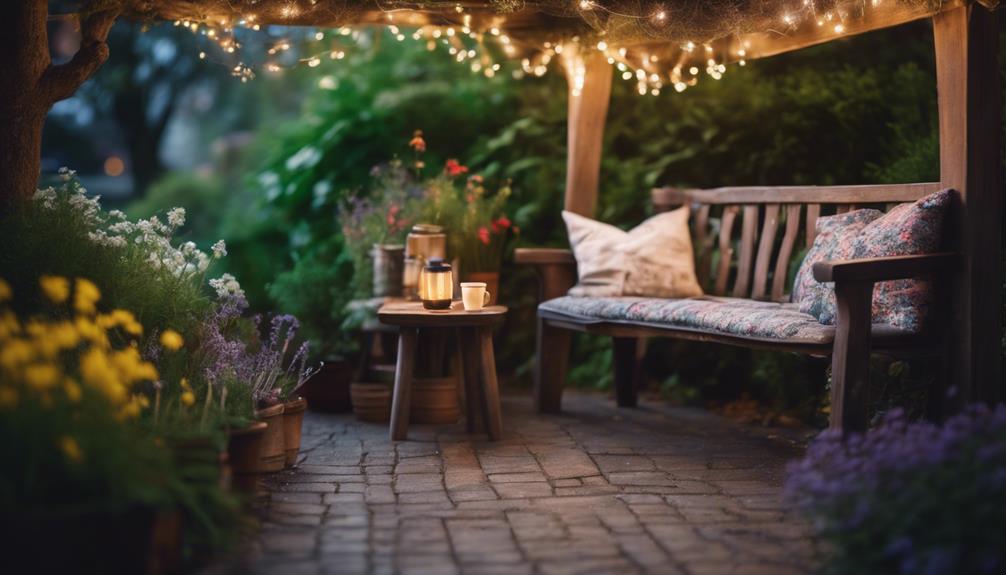
To create your perfect cottagecore garden nook, you'll want to focus on essential fixtures and furniture that reflect rustic charm.
Start with a vintage wicker garden bench for comfortable seating, and pair it with a rustic wooden side table for added functionality.
An antique iron garden trellis can enhance the enchanting atmosphere while supporting climbing plants.
Vintage Wicker Garden Bench
A vintage wicker garden bench brings both charm and comfort to your cottagecore-inspired garden nook, making it the perfect spot to unwind and enjoy nature.
When you choose a wicker bench, look for pieces made from natural materials like rattan or willow. These not only offer durability but also enhance the rustic ambiance that embodies the cottagecore aesthetic.
To keep your vintage wicker bench looking its best, apply a protective sealant to guard against weather damage and clean it regularly with a mild soap solution. This maintenance guarantees that your bench remains a cozy seating area for years to come.
For added comfort, consider dressing up your bench with soft cushions in floral or pastel patterns that complement the overall theme of your garden nook. This little touch transforms your bench into a delightful spot for reading or sipping tea.
Antique Iron Garden Trellis
Incorporating an antique iron garden trellis alongside your vintage wicker bench not only enhances the charm of your cottagecore-inspired nook but also provides a stunning support for climbing plants. These trellises serve as charming focal points, adding a vintage aesthetic that complements the rustic atmosphere of your cottagecore garden.
Look for pieces with intricate designs, as they bring a touch of artistry and character while evoking the romanticism found in classic literature. The durability of wrought iron guarantees that your antique trellis can withstand the elements, making it a long-lasting addition to your garden nook.
Plus, it allows for vertical gardening, creating a lush display of greenery and flowers without taking up too much ground space. Consider climbing roses or wisteria to drape over your trellis, adding color and fragrance to your outdoor sanctuary.
When selecting a trellis, choose one with patina or signs of age. These imperfections contribute to the overall nostalgic vibe, making your cottagecore garden even more enchanting.
With your antique iron garden trellis in place, you'll create an inviting space that encourages relaxation and daydreaming amidst nature.
Rustic Wooden Side Table
Choosing a rustic wooden side table made from reclaimed wood not only boosts the sustainability of your cottagecore garden nook but also adds a warm, inviting touch. Look for tables with natural finishes like matte or weathered wood; these enhance the organic aesthetic and blend seamlessly with your surrounding greenery.
Incorporating unique textures, such as live edges or distressed surfaces, creates visual interest and maintains that cozy rustic charm essential to the cottagecore vibe. You might also want to contemplate functional elements, like a small shelf or drawer, which can store your gardening tools or favorite books, ensuring your side table remains both practical and stylish.
To truly elevate your nook, pair the side table with vintage or handmade accessories. A delicate teacup or a fragrant herb plant can work wonders in enhancing the overall aesthetic.
This combination of rustic charm and functional design will make your garden nook a delightful retreat, inviting you to spend hours enjoying nature. So, go ahead and choose a side table that speaks to your personal style while embracing that enchanting cottagecore vibe!
Lighting Ideas
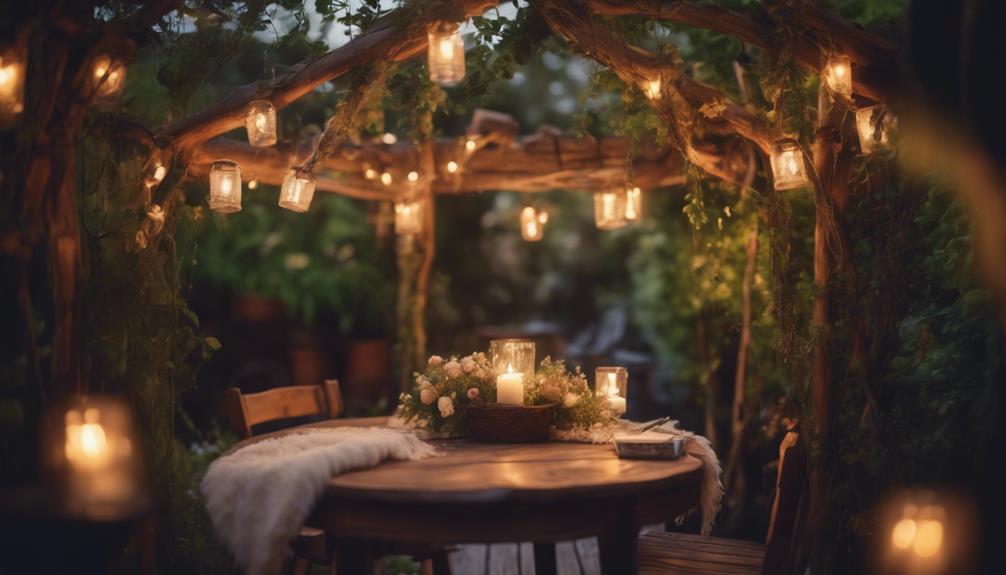
When it comes to lighting your cottagecore garden nook, you'll want to create a warm and inviting atmosphere.
Consider hanging lanterns filled with fairy lights or vintage Edison bulb string lights to add charm and character.
Solar-powered garden string lights are also a great option for a sustainable and low-maintenance glow.
Hanging Lanterns With Fairy Lights
Transform your garden nook into a magical retreat by adding hanging lanterns filled with fairy lights that cast a warm, inviting glow. By choosing lanterns made from natural materials like wood or metal, you can enhance the cottagecore aesthetic while ensuring they're weather-resistant for outdoor use.
To create an enchanting atmosphere, drape fairy lights inside or around the hanging lanterns. This allows the soft light to filter through, casting delicate patterns that dance across your garden space. Opting for solar-powered fairy lights not only enhances sustainability but also allows them to charge during the day and automatically illuminate at night, eliminating the need for additional electricity.
Position your hanging lanterns at varying heights to add visual interest and create a layered effect. This simple trick enhances the cozy atmosphere of your garden nook, making it an inviting spot for relaxation or gatherings.
With these thoughtful touches, your outdoor space will feel like a whimsical escape, perfect for enjoying quiet evenings or sharing stories with loved ones under the stars.
Solar-Powered Garden String Lights
Enhancing the charm of your garden nook, solar-powered garden string lights offer a magical glow while being eco-friendly and cost-effective. These lights harness sunlight during the day, illuminating your space at night without increasing your energy costs. Many sets come with built-in sensors that automatically turn on at dusk and off at dawn, guaranteeing hassle-free illumination.
You'll find a variety of designs and colors, from warm white to vibrant multicolored bulbs, all perfect for achieving that whimsical cottagecore aesthetic. On a full charge, solar-powered garden string lights can provide 8-12 hours of light, making them ideal for evening gatherings or quiet moments spent in your nook.
To get the most out of your solar lights, position them in areas that receive direct sunlight for at least 6-8 hours a day. This guarantees they're fully charged and ready to create a cozy atmosphere once the sun sets.
With these solar-powered garden string lights, you'll not only add beauty to your garden nook but also embrace sustainability, making your outdoor space a delightful retreat day and night.
Vintage Glass Jar Lanterns
How can vintage glass jars elevate the ambiance of your garden nook into a cozy retreat? By transforming them into charming lanterns, you can create a warm glow that beckons you to unwind. Simply fill the jars with fairy lights or LED candles for a soft, inviting light. Don't forget to mix and match jars of different sizes and shapes; this adds visual interest and dimension to your lighting setup.
For a rustic touch, decorate the vintage glass jars with twine, lace, or dried flowers. Tying these around the neck of the jar enhances their charm and fits perfectly into the cottagecore aesthetic.
If you want to create an enchanting effect, consider making hanging lanterns. Attach wire or twine to the jar lids and suspend them from tree branches or hooks to illuminate your garden nook from above.
During the day, these vintage glass jars serve as beautiful decorative pieces, and at night, they light up your space, embodying that cozy, whimsical vibe. With a little creativity, you can easily incorporate vintage glass jars into your garden nook for a magical atmosphere.
Vintage Edison Bulb String Lights
Vintage Edison bulb string lights create a warm, inviting glow that instantly adds charm to your garden nook. These lights evoke a cozy, nostalgic atmosphere, perfect for enhancing your cottagecore aesthetic. With their glass bulbs resembling early 20th-century lighting, they effortlessly bring a touch of whimsy to your space.
You can easily drape vintage Edison bulb string lights over trees, fences, or patio areas, transforming any corner of your garden into a magical retreat. They come in various lengths and designs, so you can find the perfect fit for your nook.
If you're concerned about energy consumption, don't worry—energy-efficient LED versions are widely available. They provide the same vintage aesthetic while helping you save on electricity costs.
Consider incorporating dimmable string lights to adjust the ambiance. Whether you're hosting a gathering or enjoying a quiet evening alone, having control over the brightness makes it easy to create the ideal setting.
With vintage Edison bulb string lights, you'll elevate your garden nook into a serene and inviting escape.
Decorative Elements
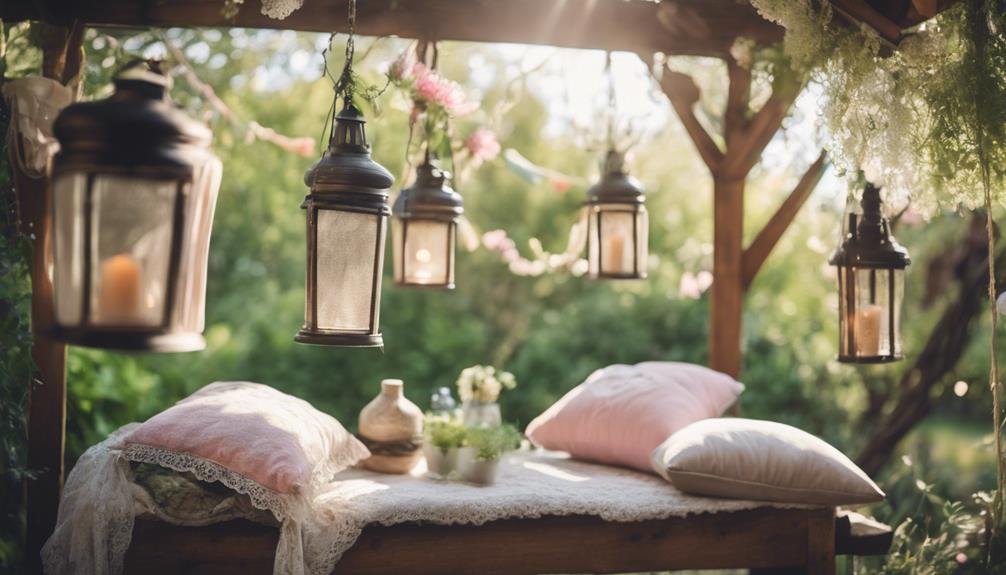
To truly capture the cottagecore vibe in your garden nook, focus on decorative elements that bring personality and warmth.
Hand-painted ceramic pots can showcase your favorite plants, while floral-patterned throw pillows add a cozy touch to your seating.
Don't forget a handmade macramé wall hanging to introduce texture and charm to your space.
Hand-Painted Ceramic Garden Pot
Hand-painted ceramic garden pots add a personal touch to your garden nook, allowing you to showcase your unique style through vibrant colors and intricate designs. By selecting non-toxic, outdoor-safe paint, you can guarantee that your creations will withstand the elements without fading.
To enhance the cottagecore vibe, consider using various sizes and shapes of hand-painted ceramic garden pots; this variety creates visual interest and depth in your space.
Don't forget to seal your painted pots with a clear waterproof sealant. This step protects your artwork from chipping and fading, guaranteeing that your garden nook remains charming through all seasons.
To complete the look, fill your pots with plants that resonate with the cottagecore aesthetic, like lavender or succulents. These plants not only complement your hand-painted pots but also contribute to the overall enchanting atmosphere.
Whether you choose whimsical patterns or more subdued designs, each hand-painted ceramic garden pot will reflect your personality and creativity. This simple decorative element can transform your garden nook into a cozy retreat that feels uniquely yours.
Embrace your creativity and watch your garden come to life!
Floral-Patterned Throw Pillows
Floral-patterned throw pillows instantly bring cottagecore charm to your garden nook, making it a cozy retreat that invites relaxation. To enhance the rustic vibe, opt for pillows made from natural materials like cotton or linen. These choices not only boost durability for outdoor settings but also align perfectly with the cottagecore aesthetic.
When selecting patterns, consider vintage or vintage-inspired motifs, such as wildflowers or botanical prints, to evoke nostalgia and a deep connection to nature. Mixing and matching different floral patterns and colors adds depth while ensuring they complement your garden's color scheme. This playful combination will create a visually appealing and inviting space.
Don't forget about size and shape! Incorporating pillows in various dimensions adds visual interest and comfort, transforming your nook into an ideal spot for reading or simply enjoying the fresh air.
With the right floral-patterned throw pillows, you can effortlessly achieve a cottagecore vibe that brings warmth and charm to your outdoor oasis. So, gather a few pillows, experiment with arrangements, and watch your garden nook bloom into a delightful retreat.
Handmade Macramé Wall Hanging
Incorporating a handmade macramé wall hanging can elevate your cottagecore-inspired garden nook, adding unique textures and a touch of rustic charm that complements your floral-patterned throw pillows. These wall hangings, crafted from cotton or jute cord, bring a natural aesthetic that resonates with the organic beauty of cottagecore.
To create your own, you'll need some basic supplies: a wooden dowel or branch for support and the skills to tie a few essential knots, like the square knot and lark's head knot. The art of macramé dates back to the 13th century, gaining popularity in the 1970s, so you're embracing a timeless craft.
For an extra connection to nature, consider incorporating dried flowers or feathers into your design. This not only enhances the visual appeal but also aligns perfectly with the cottagecore theme.
If you're new to macramé, don't worry—many online tutorials and crafting communities offer step-by-step guidance, making it accessible for everyone. So, gather your materials, release your creativity, and watch as your handmade macramé wall hanging transforms your garden nook into a cozy, inviting space.
Flooring
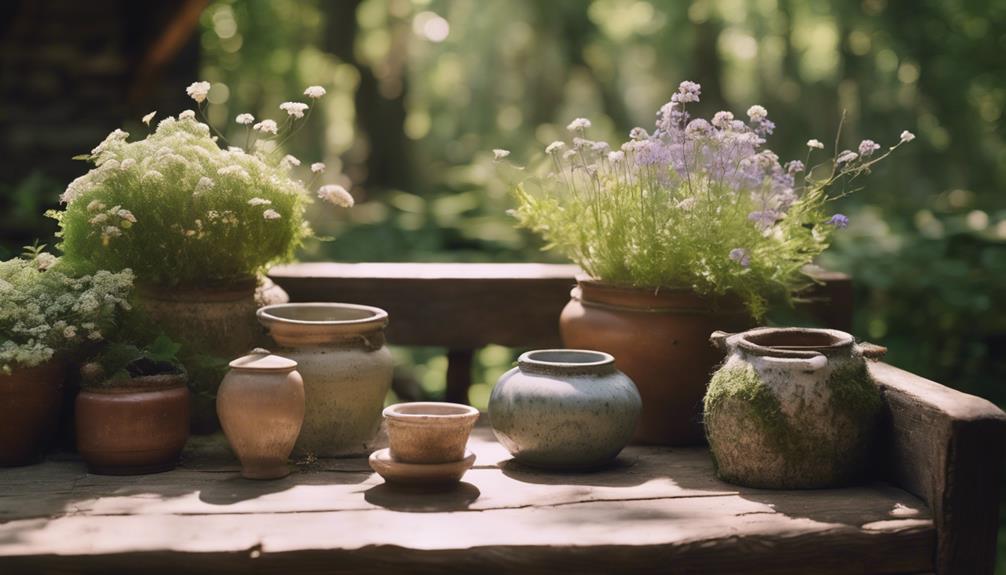
When it comes to flooring in your cottagecore-inspired garden nook, think about incorporating reclaimed wood planks for a warm, rustic vibe.
You can also design a charming cobbled stone pathway that guides you through the greenery, or simply lay down a lush green grass carpet for a natural feel underfoot.
Each option adds its own unique touch to your cozy retreat.
Reclaimed Wood Plank Flooring
Reclaimed wood plank flooring brings a unique charm and eco-friendly appeal to your cottagecore-inspired garden nook. By repurposing old wood, you're reducing waste and conserving natural resources, which aligns perfectly with the sustainable ethos of the cottagecore aesthetic. The distinctive character of reclaimed wood—complete with knots, grain variations, and weathered textures—adds a cozy, lived-in feel that invites relaxation.
Installing reclaimed wood plank flooring can be a straightforward DIY project. Many planks arrive pre-finished, while others can be easily sanded and sealed to match your personal style. This adaptability lets you create a space that reflects your tastes while being functional.
Durability is another plus. When treated appropriately, reclaimed wood can withstand outdoor conditions, making it ideal for covered garden nooks or she-sheds. This means you can enjoy your space without constant worry about wear and tear.
Incorporating reclaimed wood flooring not only beautifies your nook but also supports sustainable practices. Each plank carries a history, contributing to a story that enhances the overall charm of your garden retreat. You'll love the depth and warmth it brings to your cottagecore haven.
Cobbled Stone Pathway Design
Cobbled stone pathways add a classic, rustic charm to your garden nook, inviting you to wander through a whimsical landscape. Crafted from ethically sourced materials like limestone, granite, or sandstone, these pathways introduce unique textures and muted colors, enhancing your space's aesthetic. You can design them to wind through your garden, reminiscent of the enchanting paths found in literary gardens.
To add a personal touch, consider using natural veining stones. Each stone is distinctive, bringing character to your garden path. When installing cobbled stone pathways, it's essential to manage drainage properly. This prevents water accumulation, which can harm the integrity of the stones over time.
Not only do cobbled stone pathways enhance your garden's visual appeal, but they also create accessible routes that encourage leisurely strolls among your plants and flowers. Imagine walking along these charming paths, feeling the connection to nature while enjoying the tranquility of your cottagecore-inspired nook.
With thoughtful design and careful installation, your cobbled stone pathways will become a beloved feature, inviting you and your guests to explore and appreciate the beauty of your garden oasis.
Lush Green Grass Carpet
A lush green grass carpet transforms your garden nook into a cozy retreat, inviting you to relax and enjoy the serene beauty of nature. This soft and inviting flooring option creates a comfortable space for lounging, reading, or gathering with friends.
If you don't have a green thumb, synthetic grass carpets are the perfect solution. They're low-maintenance, requiring no watering, mowing, or fertilizers, allowing you to enjoy a beautiful garden without the upkeep.
High-quality artificial grass carpets mimic the look and feel of natural grass, with UV resistance to prevent fading over time. This guarantees your nook remains vibrant and inviting year-round. Installation is straightforward, needing minimal tools and preparation, so you can quickly transform your outdoor area.
Additionally, grass carpets come in various styles and textures, letting you choose options that best fit your desired aesthetic and complement the cottagecore theme. Whether you prefer a lush, thick carpet or a more delicate texture, there's something for everyone.
With a lush green grass carpet, you'll create a charming haven that feels like a page out of a storybook.
Conclusion
Creating a cottagecore-inspired garden nook is easier than you think, even if you don't have a green thumb.
By focusing on key elements like cozy furniture, charming lighting, and decorative touches, you can design a space that feels inviting and magical.
Remember, it's all about embracing nature's beauty, so don't stress if things aren't perfect.
With a little creativity and personal flair, your nook will become a delightful retreat that you'll love spending time in.

